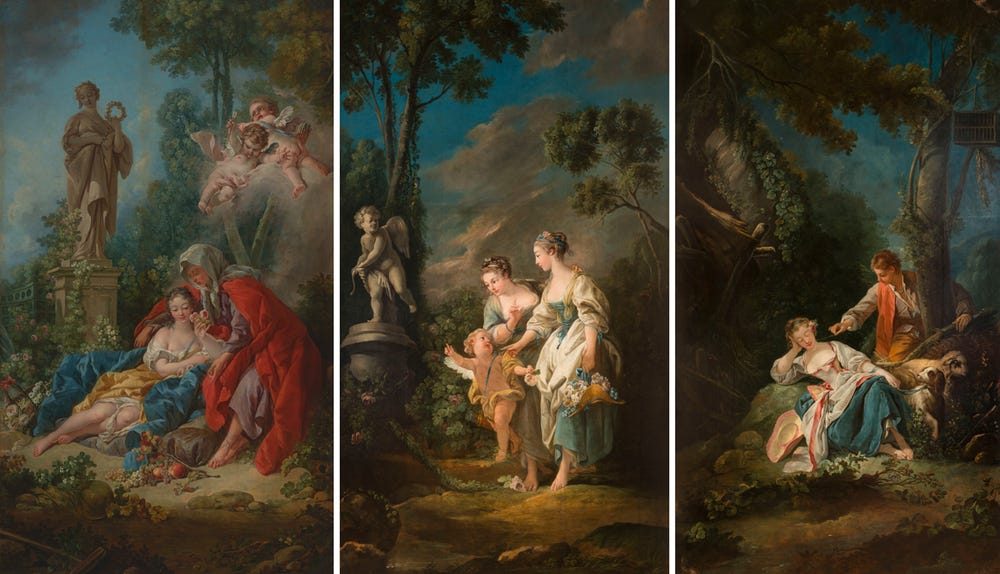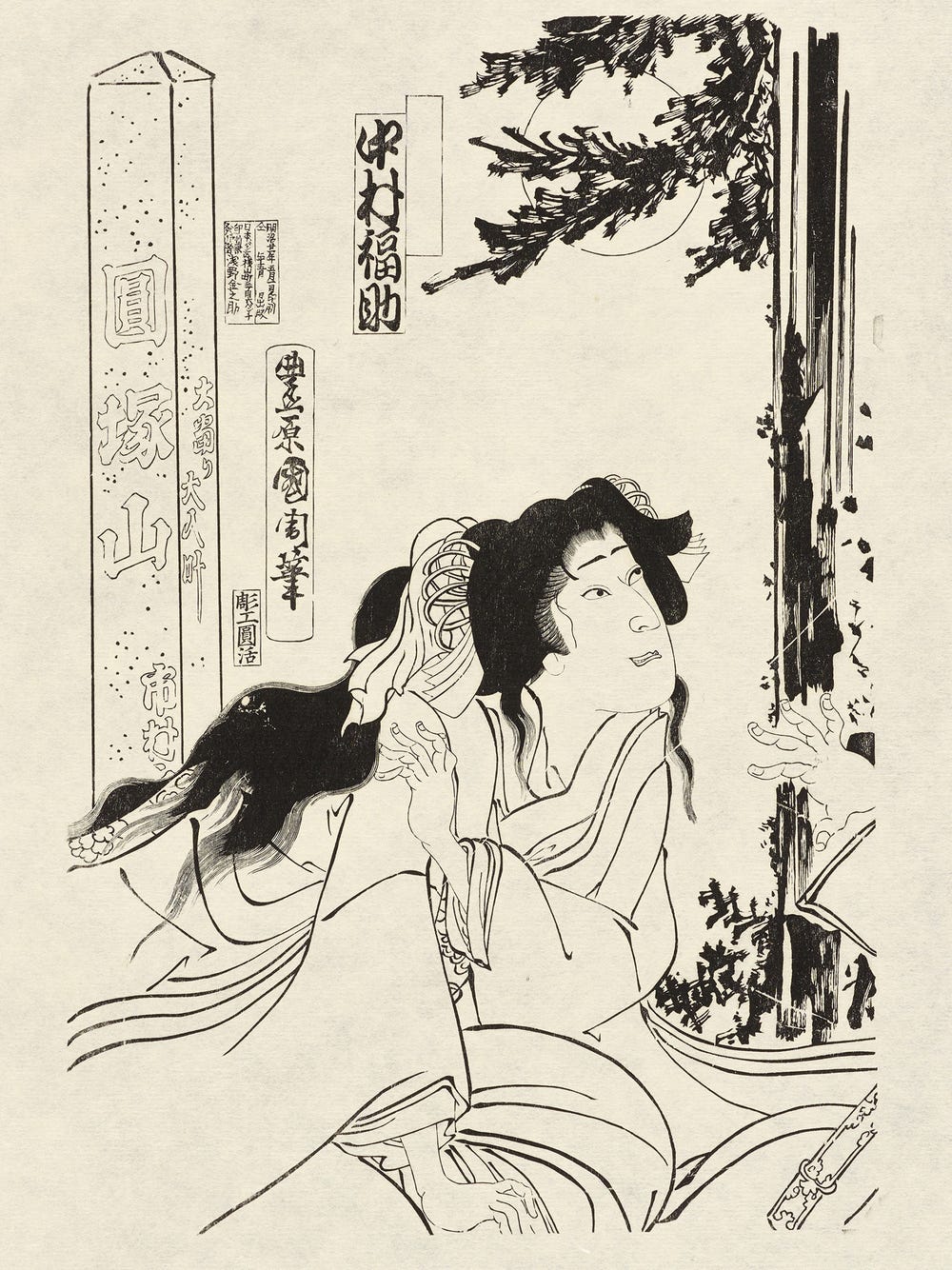Conserving Boucher: A Painting’s Relationship to Tapestry Production
By Elise Effmann Clifford, Kathryn Harada, and Sarah Kleiner
April 10, 2020
The Paintings Conservation department at the Fine Arts Museums of San Francisco is currently undertaking a three-year treatment of François Boucher’s Vertumnus and Pomona (ca. 1757), funded by a generous grant from the Getty Foundation’s Conserving Canvas Initiative. This grant has given the department a unique opportunity to take part in this international program focused on the training of younger and mid-career conservators in structural work on canvas, while also carrying out the much-needed treatment of one of the Museums’ largest paintings.
François Boucher, Vertumnus and Pomona, ca. 1757. Oil on canvas, 123 ¾ x 72 ½ in. (314.3 x 184.2 cm). Fine Arts Museums of San Francisco, Museum purchase, Mildred Anna Williams Collection, 1967.11
The Museums’ painting depicts the story of Vertumnus, the Roman god of seasons and fertility, who transforms himself into an old woman in order to seduce Pomona, the goddess of fruit and gardens. This story, recounted in Ovid’s Metamorphoses, was a popular subject with artists in the sixteenth through eighteenth centuries. Boucher first painted this subject in 1749 and returned to it throughout his career.
Kathryn Harada, Getty Conserving Canvas Fellow, surface-cleaning the front of the painting
At the start of the project, a fundamental, unanswered question conservators wished to research was whether the Vertumnus and Pomona painting served as a model for tapestries produced by the French tapestry manufacturer Beauvais or if the painting served as a cartoon — the pattern physically placed beneath a low-warp (basse-lisse) loom for weavers to follow in creating their work. Records from Beauvais indicate that seven Vertumnus and Pomona tapestries were produced by their weavers, one of which is now in the collection of the Metropolitan Museum of Art in New York. Technical study by our team of conservators has been key to deepening our understanding of this relationship to tapestry manufacture as well as the painting’s subsequent history, and has guided the course of its treatment.
While Vertumnus and Pomona was being cleaned, the conservators also studied an X-radiograph of the painting in order to understand the structural complexities hidden from the naked eye. The X-radiograph revealed that, while the original fabric was stitched together from two pieces in preparation for painting, the painting was subsequently cut after its creation. A long vertical incision, which carefully curves around Vertumnus’s hand, divides the canvas in two. The widths of the two resulting sections are typical for the strips or bandes used under the warps in low-warp weaving. Eighteenth-century weavers specialized in particular tapestry elements such as foliage and flesh, and the cut around the hand would allow the completion of the figure of Vertumnus. This finding that the painting had at one time been separated into two pieces in a manner calculated to maintain the integrity of the figures gave definitive proof that our painting is, indeed, the cartoon used to produce tapestries.
At right is an X-radiograph of Vertumnus and Pomona showing a curved cut at center
The curved cut around the hand proves that our painting was, indeed, a cartoon for tapestries woven at Beauvais.
Glimpses of the painting’s subsequent life following its use in the tapestry manufactory are revealed by the technical examination as well as through archival documentation. Records indicate in 1820 the Vertumnus and Pomona cartoon was stored at Beauvais in four bandes. While our painting is comprised of the two central pieces, the missing bandes widened the original composition and included a fountain on one side and an urn on a pedestal on the other, as revealed in the tapestry versions. By the next decade, the two central bandes had likely been reunited and adhered onto another piece of fabric creating the painting we know today. Vertumnus and Pomona appears to have been sold in 1829 in a decorative suite with three other paintings of the same dimensions.
Vertumnus and Pomona with two of its associated paintings (the fourth painting’s location is unknown): Evening and Love’s Offering, both of Casa Labia, Muizenberg, South Africa. Photographs © Michael Hall Photography
To ensure that the figures in the paintings were at the same level across all four works, an additional section comprising four pieces of painted canvas was attached along the bottom edge of the Museums’ Vertumnus and Pomona. The study of small cross-sections of paint taken in our studio, combined with the painting’s appearance in X-radiography, indicates that the later addition is made from fragments of other cartoons also created by Boucher and his workshop.
Evidence such as nail holes around the painting’s perimeter, unusual curved cutouts in the corners, and traces of gilding from frame moldings indicate that the painting and its companions were likely first installed directly to walls as part of a decorative architectural program. By 1900, when the suite of paintings was documented in a Parisian collection, each painting had been attached to its current stretcher and framed as a traditional painting. This process reduced the height of the paintings by close to a foot because a portion of the top and bottom had to be wrapped onto the reverse of the stretcher. It is in this format that the Museums’ visitors have known the painting since its acquisition in 1967.
Vertumnus and Pomona has an interesting story to tell, having undergone significant changes in format over the centuries due to its shifting functions: first as a tool for tapestry production, later as wall decor, and now as a museum painting.
One challenge in making conservation treatment decisions is choosing which aspects of a painting’s history to prioritize, and conservators and curators at the Fine Arts Museums are working closely to navigate these complex questions together. While the prior restoration efforts of Vertumnus and Pomona aimed to conceal its fragmentary nature and relationship to tapestry, the goal of the current treatment is to honor the painting’s relationship to tapestry production while also ensuring that it continues to be enjoyed for the artistic mastery of Boucher and his studio.
Kathryn Harada dusts the back of the work in the Paintings Conservation Studio
With the removal of the discolored varnish and overpaint complete, the project is now in its second phase focused on these structural issues. The canvas has been removed from its stretcher, and the conservators have been addressing the distortions and losses in the fabric. For the time being, the painting is safely sheltering in place in the conservation studio. We look forward to sharing updates on the story of Vertumnus and Pomona in the future.
Text by Elise Effmann Clifford, head of paintings conservation; Kathryn Harada, Getty Conserving Canvas fellow; and Sarah Kleiner, associate paintings conservator
Learn more about the Museums’ Paintings Conservation Studio.
Further reading on tapestry production
- Campbell, Thomas P. “How Medieval and Renaissance Tapestries Were Made.” In Heilbrunn Timeline of Art History. New York: The Metropolitan Museum of Art, 2000 (February 2008).
- “What is Tapestry?” V&A











